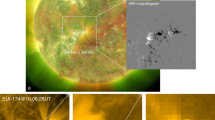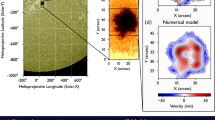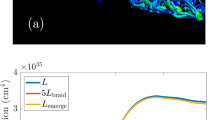Abstract
There are two possible explanations for why sunspots are dark: the partial suppression by the sunspot magnetic fields of convective energy transport from the underlying layers1, or the removal of energy from the sunspot by enhanced hydromagnetic wave radiation2. Both processes would reduce the energy emitted radiatively. The first explanation is currently favoured3, and predicts that the blocked energy should show up as a bright ring around the spot2, with the actual brightness of the ring sensitive to details of solar convective transport and sunspot structure4. Previous searches5 for these bright rings were inconclusive because of the presence of bright, vertical magnetic flux tubes near the spots, and a lack of sufficient precision in the observations. Here we report high-photometric-precision observations of bright rings around eight sunspots. The rings are about 10 K warmer than the surrounding photosphere and extend at least one sunspot radius out from the penumbra. About 10% of the radiative energy missing from the sunspots is emitted through the bright rings. We also report observations of a second set of sunspots, for which simultaneous magnetic field measurements demonstrate that the rings are not associated with vertical flux tubes.
This is a preview of subscription content, access via your institution
Access options
Subscribe to this journal
Receive 51 print issues and online access
$199.00 per year
only $3.90 per issue
Buy this article
- Purchase on Springer Link
- Instant access to full article PDF
Prices may be subject to local taxes which are calculated during checkout



Similar content being viewed by others
References
Biermann,L. Der gegenwärtige Stand der Theorie konvektiver Sonnenmodelle. Vierteljahrsch. Astron. Gesellsch. 76, 194–200 (1941).
Parker,E. N. The nature of the sunspot phenomenon. I. Solutions of the heat transport equation. Sol. Phys. 36, 249–274 (1974).
Thomas,J. H. & Weiss,N. O. in Sunspots: Theory and Observations (eds Thomas, J. H. & Weiss, N. O.) 3–59 (Kluwer, Dordrecht, 1992).
Spruit,H. C. Heat flow near obstacles in the solar convection zone. Sol. Phys. 55, 3–34 (1977).
Fowler,L. A., Foukal,P. & Duvall, T. Jr Sunspot bright rings and the thermal diffusivity of solar convection. Sol. Phys. 84, 33–44 (1983).
Neckel,H. & Labs,D. The solar radiation between 3300 and 12500 Å. Sol. Phys. 90, 205–258 (1984).
Spruit,H. C. The flow of heat near a starspot. Astron. Astrophys. 108, 356–360 (1982).
Fox,P. A., Sofia,S. & Chan,K. L. Convective flows around sunspot-like objects. Sol. Phys. 135, 15–42 (1991).
Brickhouse,N. S. & LaBonte,B. J. Mass and energy flow near sunspots I. Observations of moat properties. Sol. Phys. 115, 43–60 (1988).
Kuhn,J. R., Lin,H. & Loranz,D. Gain calibrating nonuniform image-array data using only the image data. Publ. Astron. Soc. Pacif. 103, 1097–1108 (1991).
Skumanich,A. & Lites,B. W. Stokes profile analysis and vector magnetic fields. I. Inversion of photospheric lines. Astrophys. J. 322, 473–482 (1987).
Lites,B. W., Rutten,R. J. & Berger,T. E. Dynamics of the solar chromosphere. II. CaII H2V and K2V grains versus internetwork fields. Astrophys. J. 517, 1013–1033 (1999).
Acknowledgements
We thank J. Kuhn, K. MacGregor, C. Rice, P. Seagraves, A. Skumanich, K. Streader and M. Woodard. The National Center for Atmospheric Research and the National Solar Observatory are sponsored by the National Science Foundation.
Author information
Authors and Affiliations
Corresponding author
Rights and permissions
About this article
Cite this article
Rast, M., Fox, P., Lin, H. et al. Bright rings around sunspots. Nature 401, 678–679 (1999). https://doi.org/10.1038/44343
Received:
Accepted:
Issue Date:
DOI: https://doi.org/10.1038/44343
This article is cited by
-
Long-term (1749–2015) Variations of Solar UV Spectral Indices
Solar Physics (2020)
-
Structural Invariance of Sunspot Umbrae over the Solar Cycle: 1993 – 2004
Solar Physics (2010)
-
Modeling the Subsurface Structure of Sunspots
Solar Physics (2010)
-
Solar Surface Magnetism and Irradiance on Time Scales from Days to the 11-Year Cycle
Space Science Reviews (2009)
-
Do Photospheric Brightness Structures Outside Magnetic Flux Tubes Contribute to Solar Luminosity Variation?
Solar Physics (2008)
Comments
By submitting a comment you agree to abide by our Terms and Community Guidelines. If you find something abusive or that does not comply with our terms or guidelines please flag it as inappropriate.



